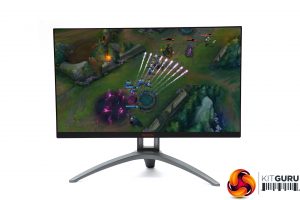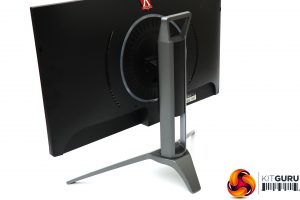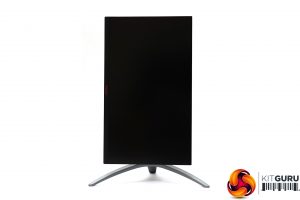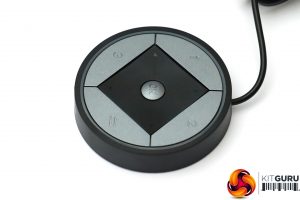The AOC AGON AG273QX comes in a typical box for a gaming monitor, with an enticing gameplay image onscreen, although we're not sure what BUFF YOUR PLAY means. Sounds a bit like cleaning shoes.
Inside are HDMI, DisplayPort and power cables, with the latter somewhat unusually being the “Mickey Mouse ears” C5 type rather than the more standard kettle lead. You also get an audio cable and USB upstream according to the specification, but we didn't find these in the box. There are also some cable-tidy attachments and bolts for VESA mounting.
The AG273QX presents a pretty serious appearance, which is the trend in gaming monitors. We do seem to be seeing a little less bling and more mature design motifs, which isn't such a bad thing. Apart from the bottom edge, the panel bezels are invisible until you turn the screen on. There is some red lighting from the centre bottom of the main unit when it's on and the rear, but otherwise the colouring is black or dark grey, and the stand has a reassuringly industrial look to its frame.
The wide feet mean you can't put this screen on a small raised desk area, but also make for greater overall stability. We also think the look is an improvement over the AOC AGON AG271QX that this screen replaces
All the usual forms of adjustment are catered for, although the distances and angles aren't as great as ASUS' competitor. The swivel range is only 30 degrees left and right, and height adjustment is through a range of 110mm. You can tilt 3.5 degrees forward or 21.5 degrees backward, and rotate the whole panel into portrait orientation. Even if these values are all less than the ASUS model, you should still be able to achieve a comfortable position.
The underside of the AG273QX is veritably bristling with connectivity. On one side is the upstream and four downstream USB 3.0 ports, plus audio minijacks for a headset and microphone input. The other side houses two DisplayPort 1.2/1.4 connections and two HDMI 2.0, plus another audio minijack input and a Mini USB connection for the external OSD control puck.
The QuickSwitch puck is one way of accessing the OSD, but you also get a joystick on the bottom centre, which is a pretty convenient place to put this compared to the usual placement on the rear that most manufacturers adopt.
 KitGuru KitGuru.net – Tech News | Hardware News | Hardware Reviews | IOS | Mobile | Gaming | Graphics Cards
KitGuru KitGuru.net – Tech News | Hardware News | Hardware Reviews | IOS | Mobile | Gaming | Graphics Cards























